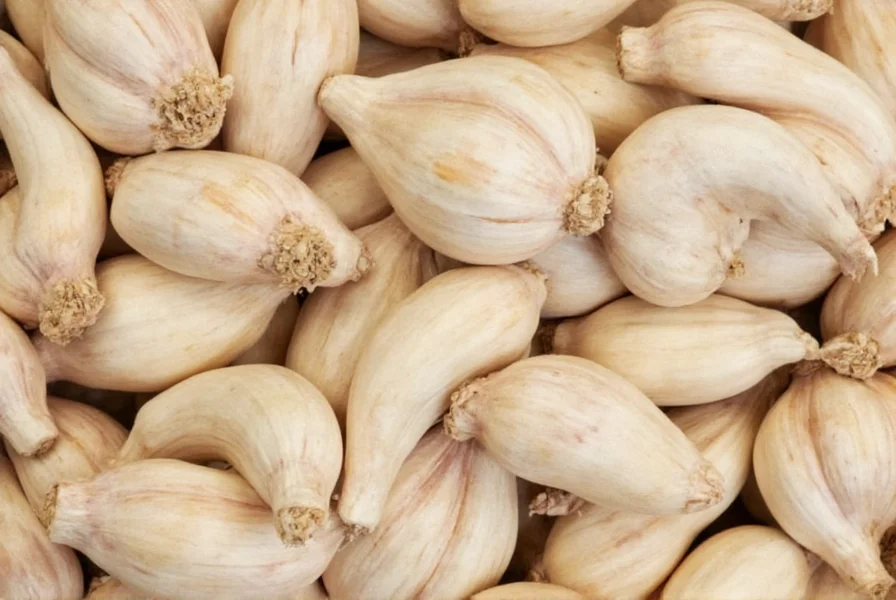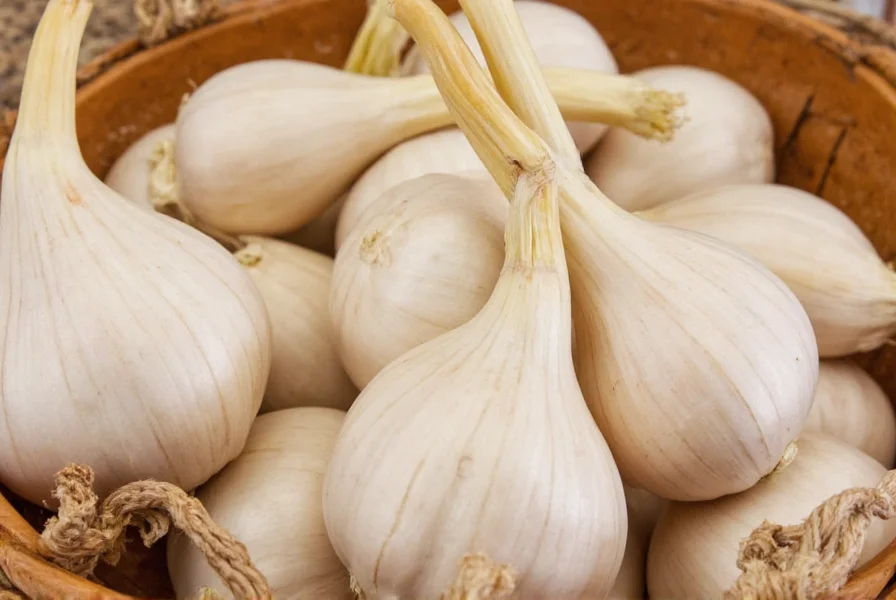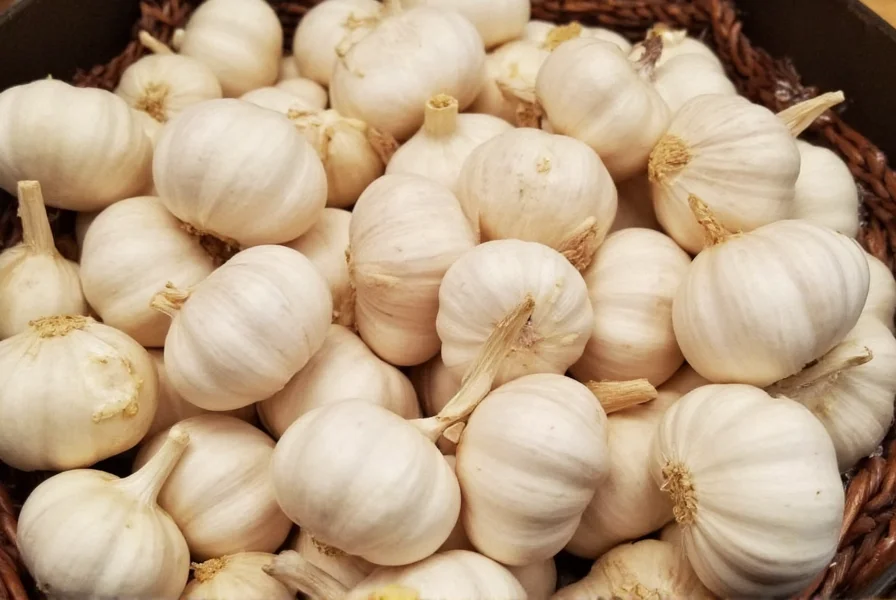When gardeners and chefs seek superior flavor complexity and cold-hardy performance, hardneck garlic cloves deliver exceptional characteristics that distinguish them from common supermarket varieties. Unlike softneck types favored for commercial production, hardnecks offer nuanced flavor profiles that transform culinary creations while thriving in northern climates where softnecks struggle.
Understanding Hardneck Garlic Anatomy
Hardneck garlic varieties develop a rigid central flowering stalk called a scape, which gives them their "hardneck" designation. This structural difference creates bulbs with fewer, larger cloves arranged symmetrically around the central stem. The cloves feature distinctive purple or violet streaking on their papery wrappers, with firm, dense flesh that stores well for 4-7 months under proper conditions.
Hardneck vs. Softneck Garlic: Key Differences
| Characteristic | Hardneck Garlic | Softneck Garlic |
|---|---|---|
| Clove Count Per Bulb | 4-12 large cloves | 10-40 smaller cloves |
| Flavor Profile | Complex, robust, nuanced | Milder, more uniform |
| Cold Tolerance | Excellent (USDA zones 3-7) | Moderate (USDA zones 5-9) |
| Storage Life | 4-7 months | 8-12 months |
| Distinctive Feature | Central woody stem (scape) | Flexible neck for braiding |
These structural differences significantly impact both cultivation and culinary applications. The presence of the central stem in hardneck varieties makes them unsuitable for braiding but contributes to their superior flavor development. Gardeners pursuing how to grow hardneck garlic in colder climates find these varieties naturally adapted to winter conditions, requiring vernalization (cold exposure) to produce properly formed bulbs.
Top Hardneck Garlic Varieties for Home Growers
Among the numerous hardneck cultivars, three categories stand out for their distinctive characteristics:
- Porcelain varieties (e.g., 'Romanian Red', 'Georgian Crystal') - Known for massive cloves (1.5-2" diameter), rich flavor, and excellent storage (6-7 months). These represent the best hardneck garlic varieties for northern climates.
- Rocambole varieties (e.g., 'Spanish Roja', 'Killarney Red') - Feature complex, nutty flavors with earthy undertones and distinctive twisted scapes. Considered by many chefs as having the most exceptional hardneck garlic culinary uses.
- Purple Stripe varieties (e.g., 'Siberian', 'Purple Glazer') - Show dramatic purple striping, medium-sized cloves, and excellent cold tolerance - ideal for gardeners exploring hardneck garlic planting guide techniques.

Optimal Growing Conditions for Hardneck Garlic
Successful cultivation of hardneck garlic begins with proper planting timing - typically 4-6 weeks before your region's first hard frost. This allows roots to establish while preventing premature top growth. The hardneck garlic planting guide essentials include:
- Soil preparation with ample organic matter (compost or well-rotted manure)
- Planting cloves pointy-end up, 2-3" deep and 6" apart
- Mulching with straw after planting to regulate soil temperature
- Consistent moisture during active growth periods
- Removing scapes when they form tight curls to redirect energy to bulb development
Gardeners following a proper when to harvest hardneck garlic schedule typically dig bulbs when the lower third of leaves turn brown, usually in mid-to-late summer. Careful curing in a shaded, well-ventilated area for 3-4 weeks develops optimal flavor and storage characteristics.
Culinary Applications of Hardneck Garlic
The complex flavor profile of hardneck garlic makes it a chef's preferred choice for dishes where garlic plays a starring role. Unlike softneck varieties that can become bitter when overcooked, hardnecks maintain their nuanced flavors through various cooking methods. The hardneck garlic culinary uses span from:
- Raw applications where their complex flavor shines in dressings and pestos
- Roasting whole bulbs to develop sweet, caramelized notes
- Creating infused oils that capture their distinctive aroma
- Adding depth to sauces, stews, and braises
Professional chefs particularly value the seasonal availability of fresh hardneck garlic ("wet garlic") in summer months, which features higher moisture content and more delicate flavor compared to cured bulbs.
Proper Storage Techniques for Maximum Shelf Life
Understanding storing hardneck garlic cloves properly extends their usability through most of the year. Unlike softneck varieties that tolerate warmer storage, hardnecks require specific conditions:
- Temperature: 55-65°F (13-18°C)
- Humidity: 50-60% relative humidity
- Air circulation: Essential to prevent mold development
- Storage containers: Mesh bags or open baskets work best
Avoid refrigeration, which triggers sprouting, and never store in sealed plastic containers. Properly cured and stored hardneck bulbs maintain quality for 4-7 months, with some porcelain varieties reaching 8 months under ideal conditions.

Health Benefits Supported by Research
While all garlic offers health-promoting compounds, hardneck varieties contain particularly high concentrations of allicin and other organosulfur compounds. Research indicates potential benefits from regular consumption of hardneck garlic health benefits including:
- Cardiovascular support through improved blood flow and cholesterol management
- Antimicrobial properties effective against various pathogens
- Anti-inflammatory effects that may reduce chronic disease risk
- Immune system modulation and support
For maximum health benefits, crush or chop cloves and allow them to rest for 10 minutes before cooking to activate beneficial enzymes. Consuming raw in moderation provides the highest concentration of active compounds.
Conclusion: Embracing Hardneck Garlic's Seasonal Excellence
Hardneck garlic cloves represent the pinnacle of flavor complexity and terroir expression in the garlic world. While they require more specific growing conditions and have shorter storage life than softneck varieties, their superior taste and cold-hardiness make them invaluable for home gardeners and culinary enthusiasts. By understanding their unique characteristics, proper cultivation techniques, and optimal usage methods, you can fully appreciate why many garlic connoisseurs consider hardneck varieties worth the extra effort.
What makes hardneck garlic cloves different from softneck varieties?
Hardneck garlic cloves come from varieties with a central woody stem (scape), resulting in fewer but larger cloves arranged symmetrically around the stem. They feature more complex flavor profiles, superior cold tolerance, and distinctive purple striping on their wrappers compared to softneck varieties, which have more numerous smaller cloves and flexible necks suitable for braiding.
When is the best time to plant hardneck garlic?
The optimal planting time for hardneck garlic is 4-6 weeks before your region's first hard frost, typically in September or October in northern climates. This timing allows roots to establish before winter while preventing premature top growth. Proper vernalization (cold exposure) is essential for hardneck varieties to develop properly formed bulbs.
How should I store hardneck garlic to maximize shelf life?
Store hardneck garlic at 55-65°F (13-18°C) with 50-60% humidity in a well-ventilated container like a mesh bag or open basket. Avoid refrigeration, which triggers sprouting, and never store in sealed plastic containers. Properly cured hardneck bulbs maintain quality for 4-7 months under these conditions, with some porcelain varieties lasting up to 8 months.
Which hardneck garlic varieties offer the best flavor for cooking?
Rocambole varieties like 'Spanish Roja' and 'Killarney Red' are widely considered to have the most complex, nutty flavors ideal for culinary applications. Porcelain varieties such as 'Romanian Red' offer rich, robust flavor with excellent storage, while Purple Stripe varieties like 'Siberian' provide a balance of flavor complexity and cold tolerance. Freshly harvested 'wet garlic' in summer months offers a more delicate flavor profile compared to cured bulbs.
Why do hardneck garlic cloves have a shorter storage life than softneck varieties?
Hardneck garlic cloves have higher moisture content and different biochemical composition compared to softneck varieties. Their central stem creates structural differences that affect how the cloves dry and cure. While softnecks have evolved for longer storage (8-12 months), hardnecks naturally maintain peak quality for 4-7 months under proper storage conditions, making them more seasonal but often more flavorful.











 浙公网安备
33010002000092号
浙公网安备
33010002000092号 浙B2-20120091-4
浙B2-20120091-4